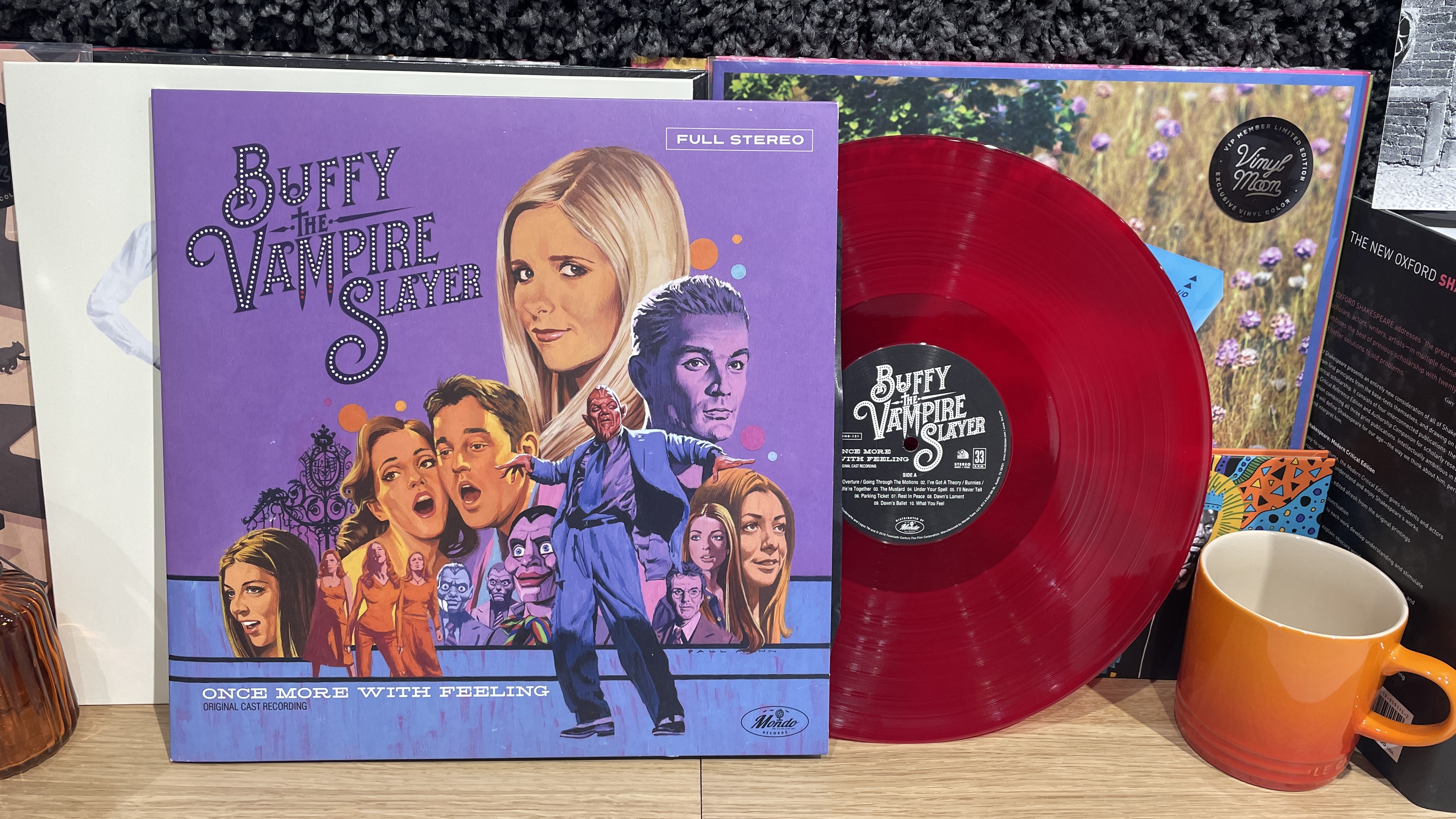I use this acclaimed album for testing all the time – you should use it to rock your system's world
Is your system down for a challenge?

There’s a relatively nascent audio brand – I won’t say the name– which prides itself on producing bass-heavy headphones built for seasoned rockers, the sort of people who pump metalcore, nu-metal and post-grunge into their brains at such ear-splitting levels that their exasperated mothers were endlessly forced to advise a serious reduction in volume. “I shouldn’t be able to hear what you’re listening to through your headphones”, was the usual, and unquestionably accurate, refrain in my house growing up, “you’ll damage your eardrums”. Considering what I now do for a living, I hope such prognostications don’t turn out to be true.
What struck me about the marketing for this particular brand of headbanger-ready headphones was that they seemed to have missed the point of the genre they were aiming to serve. The mean, industrial-looking cans promised lavish helpings of booming bass for the tattoo-plastered mosher in your life, as though a burly reproduction of the low end was all that a person into such forms of musical output should care about.
Yet while that may suffice for perhaps the most undiscerning and volume-hungry listener who only possesses two parameters through which to judge all music – how loud it goes and whether it will give them a nosebleed in the process – it does a serious disservice to the genres it supposedly serves. Considering the complexity, innovation and sonic density most ‘heavy’ albums tend to possess, replete with their complex instrumentation, free-running guitar sequences and wall-of-noise power, the idea of a pair of headphones that simply wants to whack the volume knob up to 11, especially at the lower end, feels like an exercise in missing the point.
Nowhere is this necessity for a set of headphones to possess ample sonic dexterity more apparent than the densely packed back catalogue of politically bent nu-metallers System of a Down. Dismiss them as a “no mum, I don’t want to tidy my bedroom” outfit aimed at disaffected adolescents all you want, but it’s no secret that the Armenian-American quartet have been played in our test rooms just as much as Elton John, Marvin Gaye or Kid Creole and the Coconuts. Ok, I don’t have statistical evidence for these sorts of things, but we certainly don't relegate them to the kids' table.
The point is, few bands will stretch and strain your system to the extremes that SOAD is capable of managing. Even if you’re not a System aficionado, you’ll likely have heard the band’s gangbustingly popular flagship hit Chop Suey, taken from 2002’s acclaimed release Toxicity, at least once in your life – it’s currently on 1.4 billion views on YouTube, so chances are you’ll have stumbled across it while searching for funny cat videos, makeup tutorials or the latest football highlights.
Chop Suey remains Toxicity’s flagship track, but I’d recommend, nay encourage, you to get a grip with the entirety of the album not only for your benefit but also the benefit of your hi-fi system. A meaty, dense and challenging record, it’s the sort of release you’d play if you were planning on ditching the training wheels and really wanted to see what your hi-fi or headphones were capable of, like taking your treadmill off walking mode and cranking up both the speed and the incline to their highest settings.

Let’s pin down three elements to listen out for: textural insight, organisation and dynamics, and we’ll stick with Chop Suey for now as a neat test of all three. Haunting and heaven-gazing one moment, dirty and thrashy the next, Chop Suey uses stark dynamic shifts to create an ever-changing emotional landscape, fluctuating between thin guitars and soaring dual harmonies in its quieter moments before exploding back with precise punches of sound that should be communicated with the transparency of a setup communicating a sense of drama. If that’s too basic for your system’s capabilities, isolate a single element and investigate the subtle dynamic contrasts between each note played, be it the rises and falls of lead vocalist Serj Tankian's vocals or the ever-shifting intensity and force from drummer John Dolmayan's fill-heavy playing.
Get the What Hi-Fi? Newsletter
The latest hi-fi, home cinema and tech news, reviews, buying advice and deals, direct to your inbox.
As we have hinted above, the need for organisation and cohesion from thrashy, densely layered tracks takes on a greater significance rather than being relegated to a cursory afterthought when listening to Toxicity. Uninitiated ears may consider those heavier guitar, bass and drum sections as mindless and overdone, but what we actually have are densely packed musical passages played with speed and agility, all of which must be brought out with precision and articulation by a competent setup. A strong candidate will bring out each fluctuating guitar stroke or cascading drum-fill with real clarity while keeping the core elements – guitar, bass and drums – from intermeshing into an indefinable blob of sound. On top of that, the best gear will maintain the textural authenticity and integrity of each respective instrument amidst the organised chaos – drumskins resonating, guitars screeching, the plucks of a chuntering bassline, that sort of thing.
So what else are we looking for here? Part of SOAD’s appeal is that they possess an inimitable, definable sonic signature, something that can be pointed to as identifiably unique. System of a Down don’t sound like any other band before or since, standing alone amidst the swatches of nu-metal backwards cap-wearers to craft a signature that was irresistibly theirs. Viewed from a macro perspective – Eastern-inspired sonic flavours, politically charged lyrics, punchy nu-metal sensibilities – or from the micro – the scratchy guitar and slightly flattened snare sound on X, for example – all you need to know to use Toxicity as a test record is that it should feel and sound like no other record in your arsenal. As soon as its reproduction comes off as generic, alarm bells should be ringing louder than lead guitarist Daron Malakian’s Ibanez in overdrive, an understanding that will simply come with time and exposure to the band as a whole.
Speaking of uniqueness, it would be wrong to write of the testing and technical talents of one of modern rock's greatest groups without giving props to the chops of its inimitable frontman. Malakian deserves credit for his earnest and sincere harmonising and occasional front and centre cameos (see Lonely Day from 2005’s Hypnotize), but lead man Serj Tankian’s soaring vocals – sometimes lullaby-like, sometimes storm-laden – further grant SOAD their unique and beloved sonic flavour. A sort of incomparable cross between a Muezzin’s call to prayer and a machine gun rattle in full flow, there’s never been another quite like Serj, so make sure your speakers aren't making him sound like just another '90s frontman.
Ultimately, we return to the criterion upon which all hi-fi is judged: how does this make me feel? That said, don’t consider the relationship with System’s music to be a unilateral exchange – this is music charged with political fire and borne from the outrages of war, injustice and the Armenian Genocide, so it’s as much about whether a setup can convey and transmit those emotions as much as stirring them in the listener. It's a joy to pick out the quirkier elements of Toxicity's rich tapestry of strangeness, be it the sitar on Aerials or the ludicrous backing refrains on Bounce – but stepping back and allowing yourself to be swept up in each track's compelling micro-drama is just as rewarding and, might I add, important.
Drop your preconceptions and have a taste of something a little different. It’s time to welcome your hi-fi to the weird and wonderful world of Toxicity: I hope your system is down for a challenge.
MORE:
What Hi-Fi? reviewers share their favourite-ever albums for testing hi-fi
My dream pair of wireless earbuds combines the best bits of Apple, Bose, Bowers & Wilkins and Sony
Unsure if your hi-fi is shipshape? This classic Hans Zimmer score is a treasure trove of terrific test tracks

Harry McKerrell is a senior staff writer at What Hi-Fi?. During his time at the publication, he has written countless news stories alongside features, advice and reviews of products ranging from floorstanding speakers and music streamers to over-ear headphones, wireless earbuds and portable DACs. He has covered launches from hi-fi and consumer tech brands, and major industry events including IFA, High End Munich and, of course, the Bristol Hi-Fi Show. When not at work he can be found playing hockey, practising the piano or trying to pet strangers' dogs.
